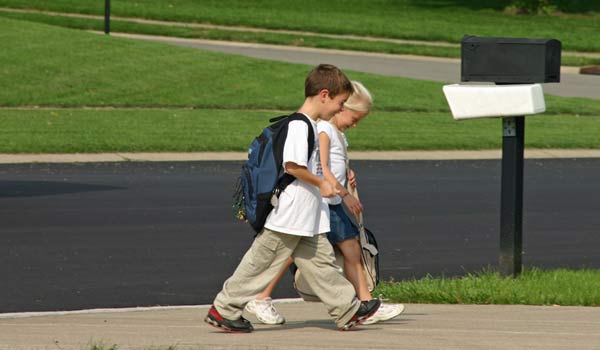Is Walking to School Good for Kids?

We've all heard it from our grandparents, but never believed it when they said, "Why, when I was your age, I walked to school every day in the snow and it was uphill both ways!"
Still, many of us can remember the days of walking to school. But with growing suburbs, the lack of sidewalks and safety concerns, the bus and the car are the most common way to get to school these days, and researchers at the University at Buffalo in New York say that change can have a significant effect on students' health and even stress levels.
The test
In a new study, the researchers designed an experiment that involved 20 boys and 20 girls between the ages of 10 and 14. To simulate a ride to school, they asked half of the students to sit in a comfortable chair for ten minutes while suburban scenes flashed by on surrounding screens. The other 20 students watched the same images, but they spent the ten minutes walking on a treadmill with a full backpack.
About 20 minutes after "arriving" at school, all students took a Stroop test, where the names of colors are printed on a card in a different color (for example, the word "red" is printed in blue ink), and students were asked to identify the written word.
During the test, the pulse of the walkers increased 3 beats per minute while the riders' heartbeat rose 11 beats per minute. Systolic blood pressure was three times higher and perceived stress was twice as high in the riders, according to the researchers.
The increase in stress is important because cardiovascular disease can begin early in life, from the elevated pulse and blood pressure that result from stress, according to the researchers. Known as cardiovascular reactivity, this condition begins the process of atherosclerosis, which clogs artery walls with cholesterol, calcium and other bad stuff.
Get the world’s most fascinating discoveries delivered straight to your inbox.
Why walking works
"The cardiovascular disease process begins in childhood, so if we can find some way of stopping or slowing that process, that would provide an important health benefit," said study researcher James Roemmich, associate professor of pediatrics and exercise at the university.
"We know that physical activity has a protective effect on the development of cardiovascular disease, and one way it may be doing so is by reducing stress reactivity," Roemmich said.
At first, this may seem like another study promoting the benefits of exercise for kids. The interesting twist is the timing of the walk to school. Roemmich believes that an early morning jaunt prepares the student for the first part of the day, which may be awhile before recess.
"This would put them in a constantly protective state against stressors that they're incurring during the school day, whether that be taking an exam, trying to fit in with peers or speaking in front of classmates," Roemmich said. The research appears in the August 2010 issue of the journal Medicine & Science in Sports & Exercise.
So, hand them their backpack, some good shoes and point them towards school in the morning. Hopefully, the journey is uphill in only one direction.
- Does Exercise Help Kids Do Better in School?
- What Causes Moms and Kids to Bond?
- What are Growing Pains?
Got a question? Email it to Life's Little Mysteries and we'll try to answer it. Due to the volume of questions, we unfortunately can't reply individually, but we will publish answers to the most intriguing questions, so check back soon.
Dan Peterson writes about sports science at Sports Are 80 Percent Mental.


